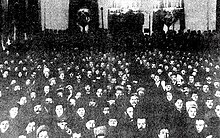All-Russian Congress of Soviets
|
All-Russian Congress of Soviets Всероссийский Съезд Советов |
|
|---|---|
|
|
|
 |
|
| Type | |
| Type | |
| History | |
| Established | 1917 |
| Disbanded | 1937 |
| Preceded by |
Russian Provisional Government Russian Constituent Assembly |
| Succeeded by | Supreme Soviet of Russia |
| Seats |
Varies in every congress:
|
| Elections | |
| Indirect elections | |
| Meeting place | |
 |
|
| Second All-Russian Congress of Soviets (November 7–9) in Petrograd, Smolny The Congress had no permanent location. |
|
Varies in every congress:
The All-Russian Congress of Soviets was the supreme governing body of the Russian Soviet Federative Socialist Republic from 1917–22 and of the Soviet Union until 1936. The 1918 Constitution of the Russian SFSR mandated that Congress shall convene at least twice a year. The 1925 constitution lowered the minimum to once a year. The October Revolution ousted the provisional government, making the Congress of Soviets the sole, and supreme governing body.
For the earlier portion of its life, the Congress was a democratic body. Over Russia there were hundreds of soviets, democratic local governing bodies in which the surrounding population could participate. The soviets elected the delegates to the Congress, and then in turn the Congress held the national authority, making the highest decisions. There were several political parties represented in the various sessions of the Congress, each of which fought for increasing their own influence in the soviets. However, as the civil war progressed, the soviets' authority was progressively reduced, with the rise to power of Stalinism effectively cementing this situation and decisively turning the Congress into a rubber-stamp parliament. The Congress was formed of representatives of city councils (1 delegate per 25,000 voters) and the congresses of the provincial (oblast) and autonomous republican councils (1 deputy for every 125,000 inhabitants).
The exclusive jurisdiction of the Congress consisted of the election of the All-Russian Central Executive Committee, adoption of the Constitution of the Russian SFSR and amendments to it, approval of amendments proposed by the central executive committee, and approval of the autonomous republics' constitutions. On the other issues, the Congress and the Central Executive Committee had the same authority. The Congress ceased to exist at the end of the constitutional reform of 1936-1937, when first on the union and then at the republican levels indirect election to Soviets were replaced by direct elections at all levels with the Supreme Soviet as the highest body.
...
Wikipedia
